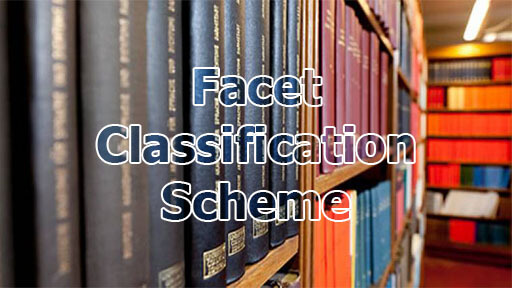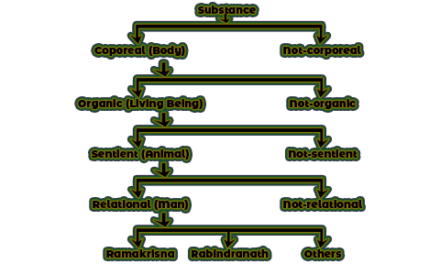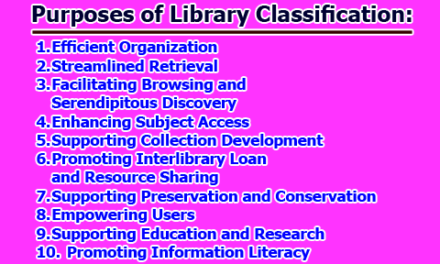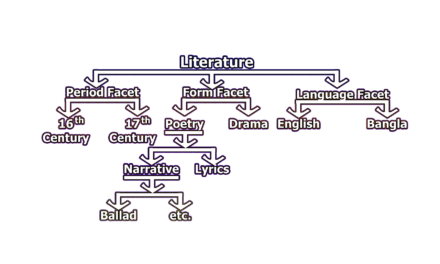Facet Classification Scheme:
A particular aspect of a subject or train of characteristics, e.g., in literature there may be four facets; language, form, author, and work. The term is used chiefly Ranganathan in the Colon Classification and explained in details. Ranganathan defined it as the totality of the sub-classes of a basic class derived by the use of single train of characteristics. A certain number of trains of characteristics, each of characteristics will yield an equal number of facet of a class. In this article, we are going to know about Facet Classification Scheme.
Definitions of Facet:
According to Merriam Webster, “Facet is any of the definable aspects that make up a subject or an object which works a smooth flat circumscribed anatomical surface.”
According to IGI Global, “A facet is an indexing system that employs several mutually exclusive metadata fields to characterize.”
Faceted Classification System:
A Faceted Classification is a classification scheme used in organizing knowledge into a systematic order. A faced classification uses semantic categories, either general or subject specific, that are combined to create the full classification entry. Many library classification systems use a combination of a fixed, enumerative taxonomy of concepts with subordinate facets that further refine the topic.
There are two primary types of classification used for information organization: Enumerative and Faceted. An enumerative classification contains a full set of entries for all concepts. A faceted classification system uses a set of semantically cohesive categories that are combined as needed to create an expression of a concept.
Advantages of Facet Classification:
Faceted classification is a versatile system for organizing and retrieving information. Here are some of its advantages:
- Flexibility: Faceted classification allows for flexibility in the organization of information, as it can accommodate a wide range of concepts and relationships between them. New facets can be added as needed, allowing for the system to adapt to changing needs.
- Post coordination: Faceted classification allows for post-coordination, meaning that multiple facets can be combined to create more specific queries and search results.
- Supports for rapidly changing fields: Faceted classification is particularly useful in rapidly changing fields, as it can accommodate new concepts and relationships as they emerge.
- Minimal theory requirement: Faceted classification does not require a deep understanding of any particular theoretical framework, making it accessible to a wide range of users.
- Classification of terms: Faceted classification provides a means for organizing terms into a structured hierarchy, allowing for easier navigation and retrieval of information.
Disadvantages of Facet Classification:
While faceted classification has many advantages, there are also some disadvantages to consider:
- Difficulty in expanding Facets: While faceted classification allows for flexibility in adding new facets, expanding existing facets can be difficult. As the number of facets grows, it becomes increasingly complex to maintain relationships among them and to ensure that the classification remains consistent.
- Lack of relationship among Facets: In some cases, facets may not have clear relationships with one another, making it challenging to organize them in a cohesive way. This can result in the system feeling disjointed or difficult to navigate.
- Resistance to visual analysis: Faceted classification can be difficult to represent visually, as the relationships among facets can be complex and difficult to illustrate in a clear way. This can make it challenging for users to understand the structure of the classification system and navigate it effectively.
Most Appropriate Scheme for Faceted Classification Scheme:
Colon Classification is most appropriate scheme for faceted classification.
Colon Classification (CC) is a system of library classification developed by S.R. Ranganathan. It was first ever faceted classification. The first edition was published in 1993.
*Features:
- Six more edition have been published.
- Its name “Colon Classification” comes from the use colons to separate facets in class number as the character.
- There are 108 main classes and 10 generalized classes in CC.
- Arabic numerals, Roman & Greek letters are used as notation.
- In CC, Facets describe Personality, Matter, Energy, Space, and Time (PMEST). These facets are generally associated with every item in a library, and so form a reasonably universal sorting system.
*Facets:
CC uses five primary categories, or facets, to further specify the sorting of a publication. Collectively, they are called PMEST.
- , (Comma) = Personality: Who, the most specific or focal subject.
- ; (semi-colon) = Matter or Property: What, the substance, properties or materials of the subject.
- : (Colon) = Energy: How, including the process, operations, and activities.
- . (Period) = Space: Where, which relates to the geographic location of the subject.
- ’ (Apostrophe) = Time: When, which refers to the dates or seasons of the subject.
*Notes:
- “ , ” = space & time before 1960.
- Omitting “ , ” is allowed.
- Further expansion of the short tables is allowed.
*Example:
Book Selection in Academic Libraries/University Libraries in U.S.A up to the 1950s.
Here,
P = Academic Libraries (23)/University Libraries (234)
M = Book (43)
E = Selection (81)
S = USA (73)
T = 1950 (N5)
\ “234;43:81.73’N5”
*Title explanation:
Basic Class: Library Science
Class No. – 2[P]
Characteristics:
1. , (Comma) = Personality: Who,
- University Libraries 34 (3 for academic Libraries and 34 for the university libraries)
= “234” (omitting “ , ” is allowed)
2. ; (semi-colon) = Matter: What,
- Book – 43 (4 for nature of publication & 3 for book)
= “234;43”
3. : (Colon) = Energy: How,
- Selection – 81 (81 for selection in general bibliography)
= “234;43:81”
4. . (Period) = Space: Where,
- USA – 73 (According to Schedule)
= “234;43:81.73”
5. ’ Apostrophe = Time: When,
- “Up to the 1950s” – N5
= “234;43:81.73’N5”
At the end of the day we can say that facet classification is the classification which one is the most appropriate in CC as faceted classification scheme.

Assistant Teacher at Zinzira Pir Mohammad Pilot School and College










